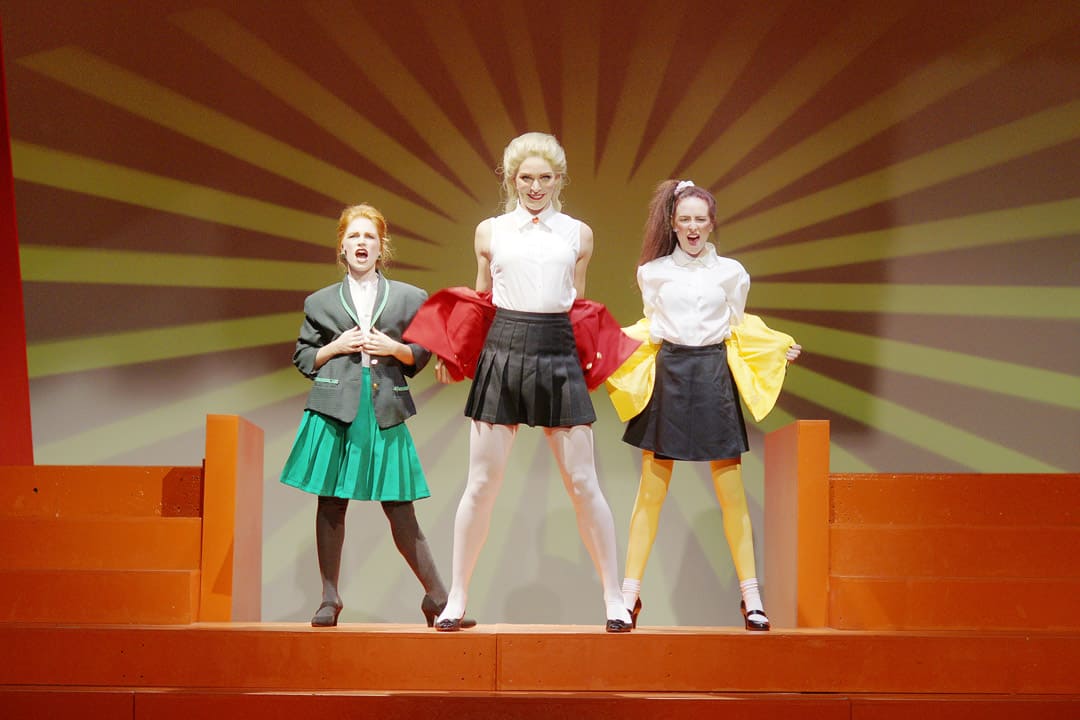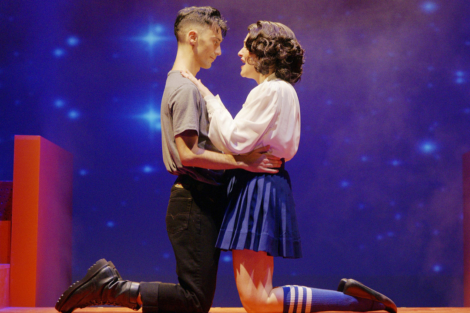Hart House opened its 2018–2019 season with a bang, or rather, a series of bangs, followed by an explosion. Adapted from the darkly comic teen film of the same name, Laurence O’Keefe and Kevin Murphy’s Heathers: The Musical premiered in Los Angeles in 2013. Released in 1988, Heathers became a cult classic for its violent characters, disturbing story, and morbidly cynical take on bullying and suicide. One can only assume that the demand for a musical adaptation was unanimous and vehement.
Director Jennifer Walls did perhaps the only reasonable thing to do with such an absurd, violent, and irreverent story: a lot. Heathers throws everything it can at the audience, seldom letting up. I entered the sold-out auditorium to the warm embrace of late-’80s pop hits, and the first thing that greeted me was the extravagant set. A brightly coloured and nightmarishly skewed vision of a high school hallway, it looked something like The Cabinet of Dr. Caligari meets Hairspray, like how a row of lockers might look if you were on a seesaw and acid. It was impressive, and immediately set the tone for this energetic and disorienting show. A barrage of bright, colourful, categorically ‘more-is-more’ sights and sounds were to come.
Our protagonist, Veronica, is a 17-year-old nobody at the fictional Westerburg High School, who is later indoctrinated into the school’s most popular group of girls, the Heathers. There are three of them, and they’re called the Heathers because each of them is named Heather. Get it?
Veronica is played by Emma Sangalli, whose enthusiasm makes the coming-of-age scenes a joy to watch. Sangalli especially shines in the smaller moments, like Veronica’s brief asides to the audience, where she takes what might have been forgettable lines or inconsequential bits of exposition and infuses them with a genuine sense of charm and spontaneity. She greets new experiences — donning her Heather outfit, getting drunk at a party for the first time — with a sort of giddy disbelief that makes her character eminently likeable.
Justan Myers has the perfect look for his character, Jason “JD” Dean, and he nails the suave punk ethos. He nails it — perhaps, a little too much though. Especially during the beginning of the show, Myers wears an almost permanent smirk, which stifles and flattens the underlying pain implied by his lines. However, he more than compensates for this in his final song “I Am Damaged,” as he explodes into a fit of seething, spitting rage that genuinely terrifies. It’s exciting to see an actor become so truly monstrous onstage and, aided by creepy chiaroscuro-like lighting, which provides a strong contrast between light and dark, Myers’ face in these moments may be the most memorable image from the show.
Oddly, Heathers succeeds most in its darkest moments. Becka Jay makes a remarkable impression in her relatively small role as Heather McNamara — the third most senior Heather, for those keeping score at home. After a series of comical and absurd murders that are framed as suicides, this Heather is the first character to actually attempt taking her own life. Jay makes the character seem truly unstable. Heathers is extreme and impassioned, but watching these scenes, I realized that I’d been somewhat starved for moments of genuine intensity. Jay’s raw, visceral agony — and JD’s similarly fever-pitched meltdown — seem to be the only answer to the bubblegum-craziness of the rest of the story.
I haven’t yet mentioned the music, because it is not very memorable, but the choreography is beautiful. It’s dynamic without being excessively complex, and most numbers end with a tableau silhouetted against a single-colour wash of backlight, which is, honestly, just cool. The band, led by Jonathan Corkal, is also excellent, particularly in more rock and funk-driven songs like “You’re Welcome.”
Despite the enjoyable instrumentation, however, “You’re Welcome” struggles to strike a balance between the comedic tone of the show and the attempted rape in the accompanied scene. It replaces a song from an earlier version of the musical, “Blue” — as in balls — which drew some criticism for making light of sexual assault. Here, the real peril of Veronica’s situation is clear, but it’s a difficult emotional balancing act for the viewer to also laugh at the jokes.
I must also mention the song “My Dead Gay Son.” There is a twist in this song, which I won’t reveal, except to say that it truly exemplifies the balls-out absurdity that the show constantly strives for. Throughout Heathers, there is an attempt to mix senselessly tragic situations with excessively cheerful pageantry to create an irreverent sense of absurd humour. The musical pulls it off with mixed success, with “You’re Welcome” in particular struggling against this tension. But “My Dead Gay Son” is such a fantastically silly culmination of so many ridiculous plotlines that I wish that the characters it focuses on had a show of their own.
When Heathers was over, I wasn’t quite sure how to feel. The play ends in a chaotic rush of so many events, increasingly outrageous, resolved and unresolved and resolved again, that you’re given no time to think anything except, “Why did they dedicate an entire song to Slurpees?” Suddenly, curtain call. I clapped for the lovely actors, staggered out of the auditorium, and tried to figure out why O’Keefe and Murphy wanted me to see what I just saw.
Something to do with inclusion? Something to do with the power of friendship?
For the discerning viewer, I’m sure there are scores of powerful messages to be drawn from this story, which touches on so many urgent and timely themes. I’d try to find just one to highlight for you, but if I think about the show much more, I’ll get brain freeze.
Heathers: The Musical ran from September 21 to October 6.



